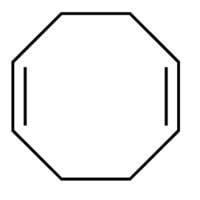Abbreviations 1,5-COD Density 882 kg/m³ | Formula C8H12 Appearance Colorless liquid | |
 | ||
1,5-Cyclooctadiene is the organic compound with the chemical formula C8H12. Generally abbreviated COD, this diene is a useful precursor to other organic compounds and serves as a ligand in organometallic chemistry. It is a colorless liquid with a strong odor. 1,5-Cyclooctadiene can be prepared by dimerization of butadiene in the presence of a nickel catalyst, a coproduct being vinylcyclohexene. Approximately 10,000 tons were produced in 2005.
Contents
Organic reactions
COD reacts with borane to give 9-borabicyclo[3.3.1]nonane, commonly known as 9-BBN, a reagent in organic chemistry used in hydroborations:
COD adds SCl2 (or similar reagents) to give 2,6-dichloro-9-thiabicyclo[3.3.1]nonane:
The resulting dichloride can be further modified as the diazide or dicyano derivative in a nucleophilic substitution aided by anchimeric assistance.
Metal complexes
1,5-COD binds to low-valent metals via both alkene groups. Metal-COD complexes are attractive because they are sufficiently stable to be isolated, often being more robust than related ethylene complexes. The stability of COD complexes is attributable to the chelate effect. The COD ligands are easily displaced by other ligands, such as phosphines.
Ni(COD)2 is prepared by reduction of anhydrous nickel acetylacetonate in the presence of the ligand, using triethylaluminium
1⁄3 [Ni(C5H7O2)2]3 + 2 COD + 2 Al(C2H5)3 → Ni(COD)2 + 2 Al(C2H5)2(C5H7O2) + C2H4 + C2H6The related Pt(COD)2 is prepared by a more circuitous route involving the dilithium cyclooctatetraene:
Li2C8H8 + PtCl2(COD) + 3 C7H10 → [Pt(C7H10)3] + 2 LiCl + C8H8 + C8H12Pt(C7H10)3 + 2 COD → Pt(COD)2 + 3 C7H10Extensive work has been reported on complexes of COD, much of which has been described in volumes 25, 26, and 28 of Inorganic Syntheses. The platinum complex is a precursor to a 16-electron complex of ethylene:
Pt(COD)2 + 3 C2H4 → Pt(C2H4)3 + 2 CODCOD complexes are useful as starting materials; one noteworthy example is the reaction:
Ni(COD)2 + 4 CO → Ni(CO)4 + 2 CODThe product Ni(CO)4 is highly toxic, thus it is advantageous to generate it in the reaction vessel upon demand. Other low-valent metal complexes of COD include cyclooctadiene rhodium chloride dimer, cyclooctadiene iridium chloride dimer, and Fe(COD)(CO)3, and Crabtree's catalyst.
The M(COD)2 complexes with nickel, palladium, and platinum have tetrahedral geometry, whereas [M(COD)2]+ complexes of rhodium and iridium are square planar.
The highly strained trans,trans isomer of 1,5-cyclooctadiene is a known compound. (E,E)-COD was first synthesized by Whitesides and Cope in 1969 by photoisomerization of the cis,cis compound. Another synthesis (double elimination reaction from a cyclooctane ring) was reported by Huisgen in 1987. The molecular conformation of (E,E)-COD is twisted rather than chair-like. The compound has been investigated as a click chemistry mediator.
